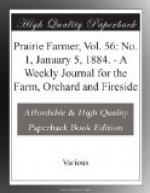M. Paul Bert seems to be a true demagogue, otherwise he would not resort to a falsehood to please his constituents. I never in any manner, directly or indirectly, stated or intimated that packers are or ever were in collusion with dealers in diseased live stock. Moreover, the laws and regulations of the Chicago Stock Yards are such as to render it absolutely impossible that a dead hog should be smuggled into them, and if an animal should die while in the yards it is at once delivered to a soap-grease rendering establishment outside of the Stock Yards, and can not possibly get into a packing-house.
This reply came too late to have any effect upon French legislation, and the decree of prohibition has been re-enacted. So far we notice no marked effect upon the prices of pork products in this country, but later it must result in depression. We notice the leading papers of the United States are advocating the retaliatory measures proposed months ago by THE PRAIRIE FARMER against European States interdicting the importation of our meat products. We refer to the prohibition of French and German adulterated and poisonous wines and liquors, and dry goods and silk goods colored with poisonous dyes. It must come to this at last if such totally unreasonable legislation against American products is to continue in those countries.
CORN, WHEAT, AND COTTON.
The preliminary crop estimates by the Statistician of the Department of Agriculture have been completed. He says the average yield of corn per acre for 1883 was within a fraction of twenty-three bushels, which is 12 per cent less than the average for a series of several years past. The quality is another thing.
It is doubtless true, Mr. Dodge says, that the quality of the corn north of parallel forty is worse than for many years, increasing practically the amount of shortage indicated by the number of bushels. As the whole corn grown in 1883 in Michigan, Wisconsin, Minnesota, and Dakota, added to half that grown in Ohio, Indiana, Illinois, Iowa, and Nebraska, would make 400,000,000 bushels only—a fourth of the whole crop—so that the possible depreciation of 40 per cent in all of it would be equivalent to a 10 per cent reduction in the value of the entire crop. The Illinois Department agents make the quality 31 per cent less than the average in this State. An effort will be made later, after the worst of the crop has been fed, to ascertain the feeding value of the year’s product. It is not proposed, however, to reduce the product to the equivalent of merchantable corn, or “sound” corn, as no crop ever is free from immaturity or imperfection. There always are some Northern fields caught by frost, some neglected acres, some choked with weeds or flooded




